

J.F.Drew © 2000-2017






Mobile menus
VK5DJ
Voice ID for the VK5DJ repeater controller
This is preliminary information regarding a new program for the repeater controller that enables a choice to be made between a CW ID or a Voice ID.
This project shares pins that may be used for other functions, in particular Acfail and External Relay. Depending on how you wire things to peripherals and on how you activate commands 13 & 14 you determine how the controller behaves. Once you have chosen voice then the other two features must be made unavailable with DTMF commands. See Commands 13 and 14 in the manual.
The new feature controls the common ISD1820 voice chip in play back mode only. Pin 16 (freed by the no longer needed oscillator input) and pin 4 (the MCLR connection previously used by the AC fail function) are accessed for this version.
The voice chip board can be found here:
Voice-Sound-Board-Recording-Recorder-Playback-Module
The hex file (V706 voice.hex) for the PIC16F1827 is here. The document file V7.06 is here.
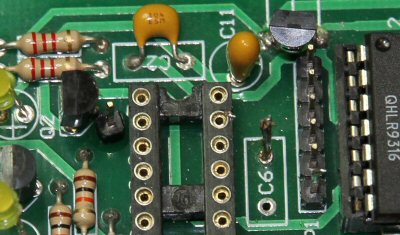
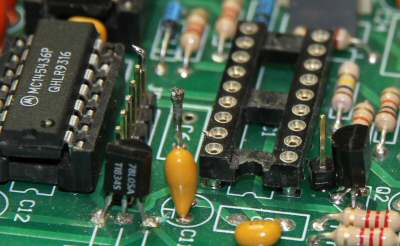
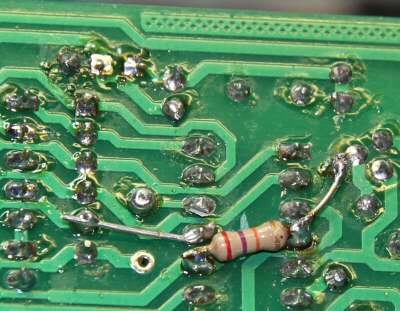
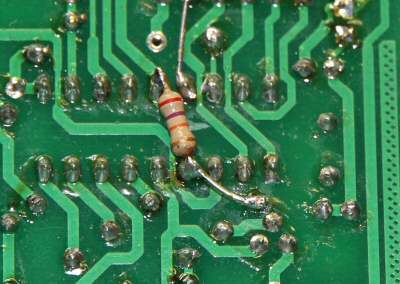
Top view
It is necessary to add two pins to the board. The picture to the left shows the position of these.
The first (Pin A) is to the left of pin 2 of the PIC16F1827. A hole is bored from the trace side in a spot that avoids traces. The pin is glued to the board with epoxy resin.
In this photo the newly glued pin A can be seen with its black base.
The second pin B is placed in the top unused hole where C6 was placed in old versions of the controller.
The photos makes the position of Pin B clear.
The photo to the left is an alternate view looking into the board. The 78L05 regulator can be seen in the foreground.
The PIC16F1827 is not installed at this point.
Bottom view
The trace between pin 4 and pin 14 is cut and a resistor of 27K or more is soldered between the pins 4 and 14. A piece of wire joins the Pics pin 4 to the newly added pin A.
The addition of the resistor is optional. It is there in case no audio board is connected which would result in a PIC pin floating and left in an indeterminate state. A floating pin can cause undue current drain.
In my case I just continued the lead of the resistor to complete the connection to Pin A.
The board will also function equally well if you take the resistor from pin 4 to earth.
The photo to the left is an alternate view to show more clearly the connection to the new pin A.
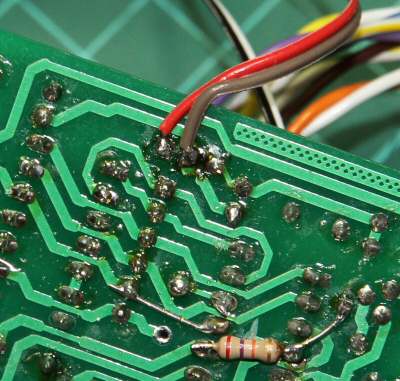
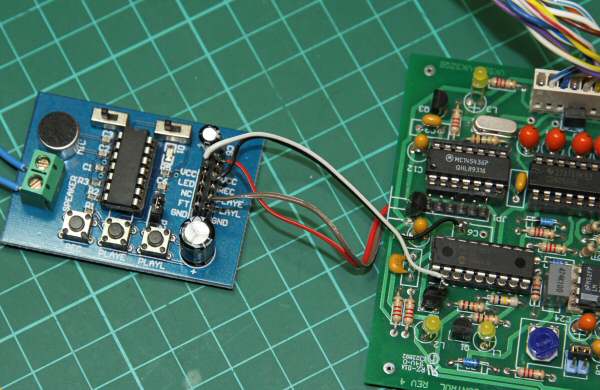
Under view power connection
Power for the player board is obtained from the connections to the 78L05 regulator. Mind you access the right side of the chip. The earth is the centre connection and the +5V is available on the side closest to the MC145436. The wrong side of the 78L05 will result in audio board and controller destruction due to +12V so be careful.
The bottom right of the photo shows the added resistor. The cut in the trace is concealed by the resistor.
Above
The completed unit.
Two things to note, firstly as this is a player only you need to pre-record your message. This can be done when the board is powered up and holding the record button during your up to 12 second recording. Alternately you may choose to use a better quality audio input to the recorder for a higher definition recording. The microphone on the unit is only so so! Secondly you will need to find your own way of mixing the audio from the recorder into the transmitter. The device has quite a high level from the speaker output. Some treble cut might help with the relatively high level of hiss.
The controller software permits talk over the ID, although generally this would be considered not a polite thing to do.
The remote control command 13 has been added. Ensure command 14 is set to 0 (default)
<Pwd> 13 00 = CW ID
<Pwd> 13 01 = Voice ID
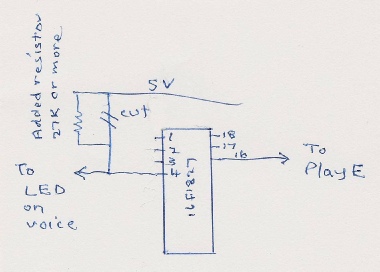
To the right is the circuit alteration for voice.
Pin 16 has been freed by the absence of C6 and instead goes to PlayE on the recorder board.
Pin 4 is removed from the +5V on pin 14 by cutting the trace. A large value resistor is placed across the cut. This resistor could be omitted as long as you are confident the pin will never be left floating.
| Repeater features |
| Solar version |
| 1750Hz decoder |
| Record and playback |
| Voice interface |
| Micor solution |
| Yagi Calculator |
| RD Contest logger |
| Moon Tracking |
| Orbitron interface |
| PRFCalc |
| TAIT programming |
| Proton Development Suite |
| Old crystals for radios |
| Compound interest |
| Yagi photos |
| Bird proofing |
| Bender |
| VK5DJ downloads |
| VK3UM downloads |
| Site map |